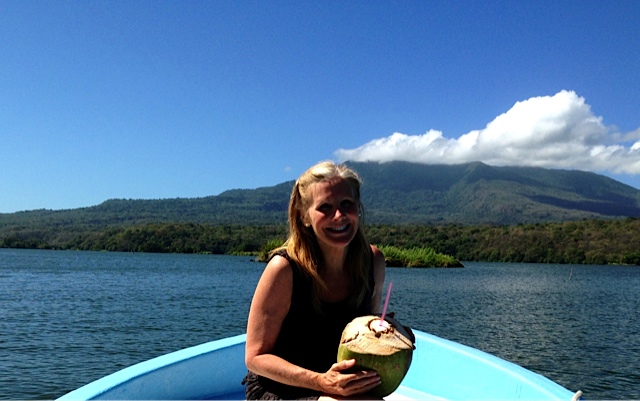| I believe we all need sunshine. The sun promotes health and vitality. Just about every living thing on earth benefits from the sun. Just getting a little sunlight through your eyes, on your face, arms, and legs once daily can be incredibly important to your health. We need to be aware of the safest way to be out in the sun, especially in the summer (which in the northern hemisphere is almost here).
If you must use a sunscreen, for whatever reason, let’s look at some choices. Which sunscreens are safe and healthy to use? |
How do you pick a safe sunscreen? |
| Unfortunaley, some sunscreens have carcinogenic ingredients and hormone disrupters that should be avoided: Oxtinoxate, Octisalate, Oxybenzone, Homosalate, Avobenzone, and Retinyl Palmitate (a form of Vitamin A). Be sure to check any sunscreens for these ingredients; they absorb easily through the skin and are toxic when combined with sun exposure.
Dr. Elizabeth Plourde, in her research paper “Exposing the Hazards of Sunscreen,” says there is concern that “sunscreen chemicals should be examined in relation to rising autism rates.” If you are interested in this subject, read her paper. (2) She also found that they were the reason coral reefs are dying. Dr. Plourde found that sunscreens are a major toxin to coral reefs and could be a predominant factor in their decline. When exposed to sunscreens, “Coral dies in 96 hours. Plankton dies, jeopardizing our vital-to-life source of food and oxygen. Fish become intersexed, and some even stop spawning.” |
| If you are interested in any of these subjects (autism, coral death, etc.),I recommend reading her papers or books. (They are trying to ban these toxic sunscreens fromHawaii, because they are harming the coral reefs and aquatic life.) Aquatic life is threatened by these toxins in sunscreens. Do not wear them into the water, if you have them on. Wash them off first. |
| Which Sunscreens Are Safe to Buy?
Look for sunscreens that are non-nano, because extremely small particles can penetrate the skin. You want particles so large they cannot penetrate skin.
The Environmental Workers Group (EWG) tested more than 1,500 sunscreens for safety and effectiveness. (3) The sunscreens listed below is one they compiled as the ones they felt were better, because they contain either zinc oxide or titanium dioxide in some form. (4) |
| I personally don’t wear sunscreen unless it is made of non-toxic essential oils, and then only when I’m at the beach all day long and unable to get under some shade.
Another healthy alternative which I use is a new technology by a company called Lifewave, including patches. There are a few things I do with this technology to help protect my skin from sunburn. First, before I go out in the sun, I put on both the X39 and X49 patches. David Schmidt, the inventor of Lifewave, has said that studies show that when these patches are worn together, they not only help protect the body from harmful radiation, which can include too much sun, but also cell phones, and other EMF-emitting devices. (5) |
|
If I do happen to get too much sun, I put on a carnosine patch, which is also beneficial for heart health, the cardiovascular system, and sugar issues. Carnosine is highly effective for tissue repair and speeds healing for burns.
I also use the Lifewave Alavida Day and Night Creams to help my skin recover and heal quickly.In addition to all of those things, I drink and eat a lot of plant-based whole, organic food that can provide some natural sun protection. Drinking carrot juice or eating carrots, gives the body some natural sun protection due to beta carotene. (6) The color pigments in fruits and vegetables are the antioxidants. These color pigments (like beta carotene) include carotenoids contributing red, yellow, and orange (carrot, apricot, tomato, orange…) and flavonoids contributing yellow (grapefruit, lemons…). The antioxidants in plants protect the plant from harmful UV damage. But they also help our bodies when we consume them. Studies show that an antioxidant-rich plant-based diet, high in carotenoids may contribute to life-long protection from harmful UV radiation.(7)I highly recommend that you eat more colorful, organic, fresh fruits and vegetables as a part of your daily dining experience. You will be rewarded with the wonderful health benefits this can bring to you, in so many ways. In conclusion: I love the sun and the sunshine, but I’m careful not to get burned. Being thoughtful about these things can help keep your body and skin healthy. |
|
Sources: 2.“Exposing the Hazards of Sunscreen.” Elizabeth Plourde, CLS,NCMP, PhD. Price-Pottenger Journal Vol. 36, No. 1.3. “Sunscreens Exposed: 9 Surprising Truths. 3. & 4. EWG’s Skin Deep—Sunscreens 2011.” Environmental Working Group website. June 20, 2011. http://www.ewg.org/enviroblog/2011/06/9- surprising-truths-about-sunscreen/. 5, Lifewave – David Schmidt CEO LifeWave December 4 2021 Hosted By Michael Accurso.mp4 – https://drive.google.com/file/d/1dy7YtsdR3OIePfO02rtwwWmDRbhiPjhU/view 6. Antioxidant Activity and Healthy Benefits of Natural Pigments in Fruits: A Review https://pmc.ncbi.nlm.nih.gov/articles/PMC8125642/ 7. Lycopene-rich products and dietary photoprotection https://pubmed.ncbi.nlm.nih.gov/16465309/
Nancy’s 7 books on Amazon are also in Audio and some of them are in large print: Medical Disclaimer: Information provided in this video or audio and the use of any products or services related to this video by you DOES NOT create a health counselor-client relationship between you and Nancy Addison, certified health counselor. Information and statements regarding dietary supplements have not been evaluated by the Food and Drug Administration and are not intended to diagnose, treat, cure, or prevent any disease.
|


